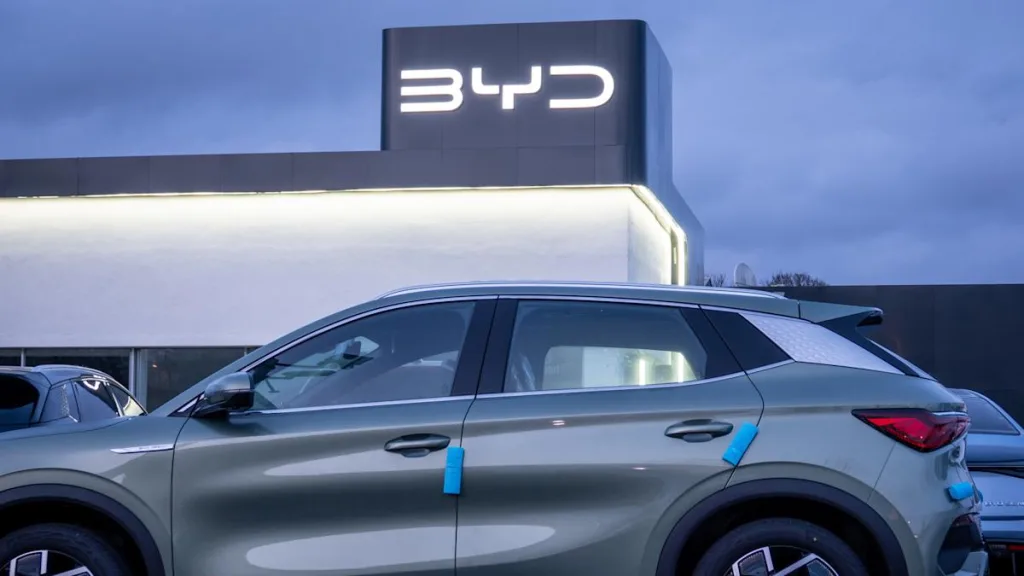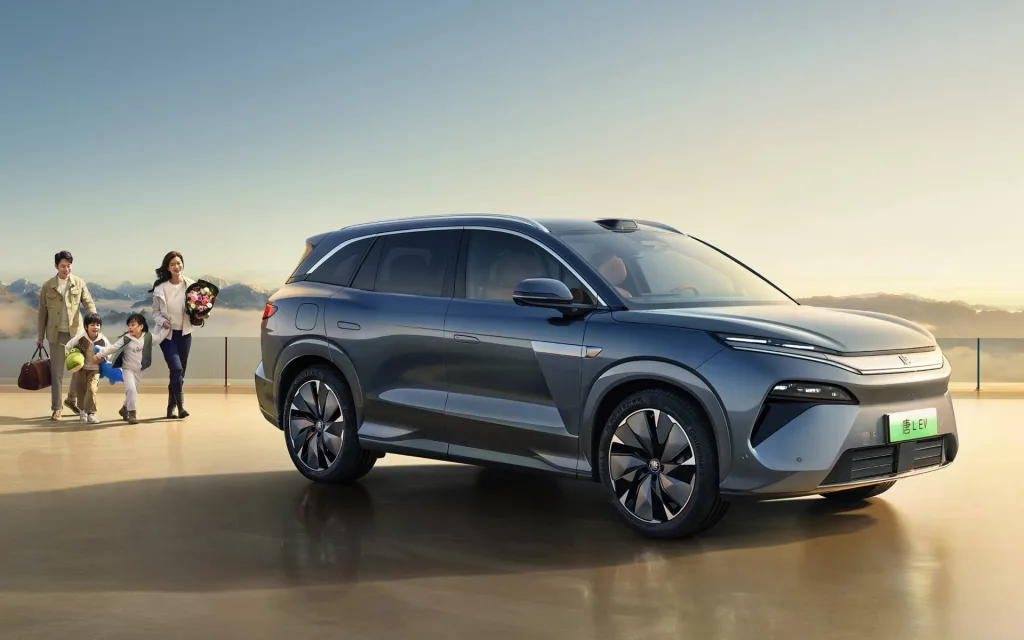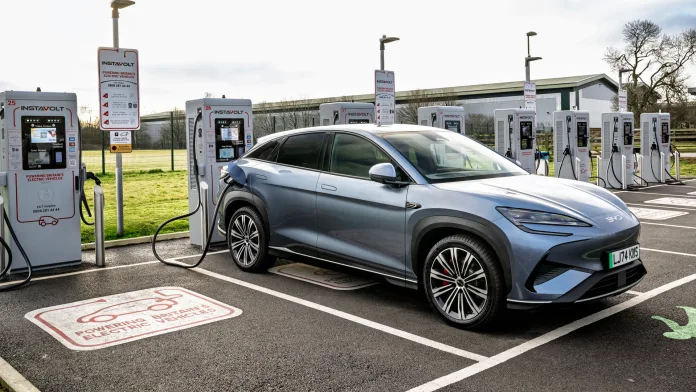Imagine pulling up to a charging station in your electric vehicle, plugging in for just five minutes, and driving away with enough power to travel 400 kilometers (248 miles). This isn’t science fiction—it’s the new reality BYD is creating with their groundbreaking charging technology.
Chinese automotive giant BYD has announced plans to deploy high-capacity electric vehicle chargers across China, with power outputs reaching an unprecedented 1,360 kW. This development could fundamentally change how we think about electric vehicle charging and adoption.
Table of Contents
Ultra-Fast Charging Technology: How BYD’s 1,360 kW System Works

The ultra fast charging technology developed by BYD represents a quantum leap forward in EV infrastructure. Current fast chargers typically deliver between 50 kW and 350 kW of power. By comparison, BYD’s new system operates at nearly four times the capacity of even the most powerful chargers in Tesla’s Supercharger network.
“This is like going from dial-up internet to fiber optic broadband,” explains Li Wei, an automotive technology analyst based in Shanghai. “The difference in charging speed is that dramatic.”
For compatible BYD vehicles, these chargers can deliver approximately 400km of range in just five minutes. This charging speed approaches the convenience of refueling a traditional gasoline vehicle, effectively eliminating one of the most significant barriers to EV adoption.
The technology works by:
- Delivering unprecedented power levels (1,360 kW) to the vehicle
- Utilizing advanced battery management systems to handle the incoming power safely
- Employing sophisticated cooling systems to manage heat generation
- Optimizing power delivery based on the vehicle’s current charge state
Technical Specifications Comparison
| Charging System | Maximum Power Output | Charging Time (400km range) |
|---|---|---|
| BYD New Charger | 1,360 kW | ~5 minutes |
| Tesla Supercharger V3 | 250 kW | ~20-25 minutes |
| Typical DC Fast Charger | 50-150 kW | ~30-60 minutes |
| Standard Level 2 Charger | 7-22 kW | Several hours |
When comparing BYD EV chargers with Tesla Superchargers, the Chinese manufacturer’s 1,360 kW output significantly outpaces Tesla’s typical 250 kW maximum. This represents more than just an incremental improvement—it’s a fundamental rethinking of what’s possible in EV charging technology.
BYD Charging Station Network: 4,000 Units Planned Across China
BYD isn’t just developing the technology—they’re building the infrastructure to support it. The company has announced plans to deploy over 4,000 of these high-capacity chargers throughout China, creating a network that could transform the country’s EV landscape.
Each BYD charging station in the new network will feature the company’s groundbreaking high-capacity charging technology. The ambitious rollout represents one of the largest investments in next-generation charging infrastructure globally.
“The scale of this deployment is impressive,” says Zhang Min, an electric vehicle infrastructure specialist. “With 4,000 stations, BYD is creating a network that could significantly reduce charging anxiety for millions of drivers.”
The initial focus will be on major urban centers and key highway corridors, with plans to expand to more remote areas as adoption increases. This strategic deployment aims to make ultra-fast charging accessible to the maximum number of drivers.
EV Charging News: BYD’s Technology Leapfrogs Competition
This EV charging news represents a significant milestone in addressing one of the primary barriers to widespread electric vehicle adoption. Industry experts have long identified charging time as a critical factor limiting EV acceptance, particularly for consumers accustomed to the convenience of quick refueling at gas stations.
The benefits of BYD EV charging technology include dramatically reduced waiting times and enhanced convenience for electric vehicle owners. By bringing charging times closer to the refueling experience of conventional vehicles, BYD is removing a major psychological barrier to EV adoption.

“What BYD has accomplished here is remarkable,” notes Dr. Sarah Chen, director of electric mobility research at a leading technology institute. “They’ve essentially solved one of the fundamental challenges of electric vehicles. When you can charge in roughly the same time it takes to fill a gas tank, the ‘inconvenience’ argument against EVs largely disappears.”
Will BYD’s Technology Influence Best Home EV Charger Design?
While these industrial-strength systems differ from the best home EV charger options, the technology may eventually influence residential charging solutions. Current home chargers typically deliver between 7-22 kW of power, limited by residential electrical systems.
However, the innovations developed for these ultra-high-capacity chargers could eventually trickle down to home charging technology:
- More efficient power conversion
- Advanced thermal management
- Smarter load balancing
- Improved battery management protocols
“We’re seeing the future of charging technology,” explains electrical engineer Thomas Rodriguez. “While residential electrical systems can’t support 1,000+ kW charging, the underlying innovations will likely influence the next generation of home charging solutions.”
BYD Atto 3 Charging Specifications and Compatibility
BYD’s current EV lineup, including the popular Atto 3, showcases the company’s commitment to advancing electric vehicle technology. The Atto 3 comes with:
- Battery options: 49.92kWh and 60.48kWh packs
- Range: ARAI-certified range of 468km and 521km respectively
- Pricing: Starting from Rs. 24.99 lakh (ex-showroom)
While the Atto 3 isn’t currently equipped to handle the full 1,360 kW charging capacity, BYD has indicated that future models will be designed to take advantage of the ultra-fast charging capabilities. This suggests a roadmap where vehicle technology and charging infrastructure evolve in tandem.
Global Implications for EV Charging Infrastructure
The impact of BYD’s charging innovation extends far beyond China’s borders. As global markets watch this development, several implications become clear:
- Accelerated Competition: Other charging network providers and automakers will likely accelerate their R&D efforts to remain competitive.
- Infrastructure Standards: This could influence global standards for next-generation charging systems.
- Grid Challenges: Power grids worldwide will need to adapt to support high-capacity charging networks.
- Consumer Expectations: As awareness of this technology spreads, consumer expectations around charging times may shift dramatically.
“What happens in China’s EV market increasingly influences global trends,” observes Maria Gonzalez, an international energy policy analyst. “BYD’s charging breakthrough could accelerate the timeline for similar deployments worldwide.”

The Future of Electric Vehicle Charging
BYD’s breakthrough in charging technology signals a new chapter in the electric vehicle story. As charging times approach the convenience of traditional refueling, one of the last major barriers to widespread EV adoption begins to fall.
The race to develop and deploy ultra-fast charging technology is likely to intensify in the coming years, with benefits for consumers worldwide. As manufacturers compete to deliver the fastest, most convenient charging experience, the entire EV ecosystem will evolve.
For now, BYD has established itself as a pioneer in this critical technology. Their ambitious deployment of 4,000 high-capacity chargers across China represents not just a business strategy, but a vision for the future of transportation—one where electric vehicles can be recharged almost as quickly as filling a gas tank.
As this technology matures and spreads globally, it may well be remembered as the tipping point when electric vehicles truly began to replace their fossil-fueled predecessors.


